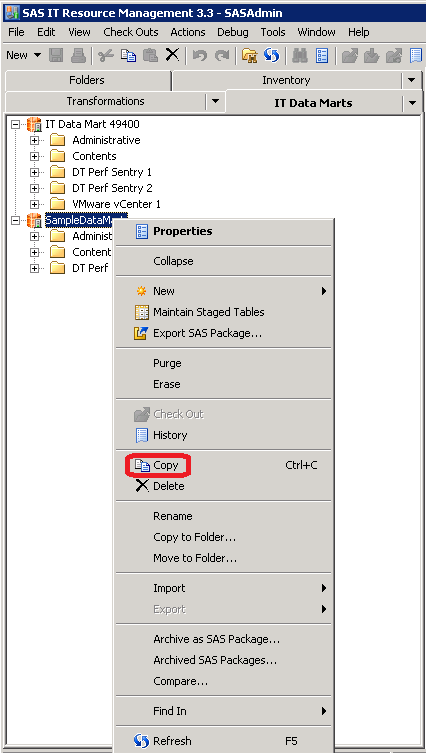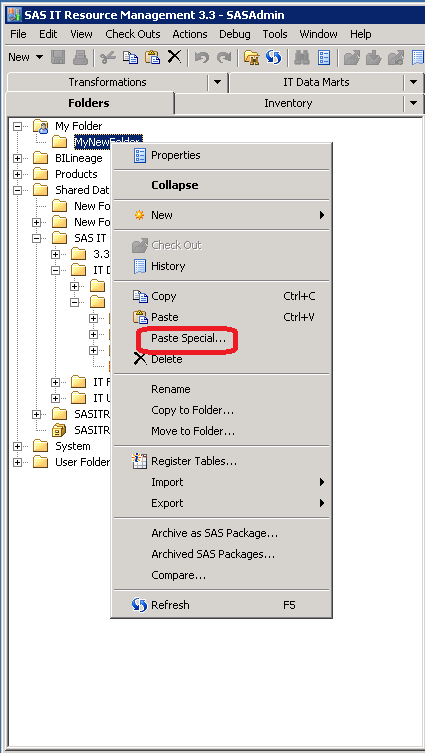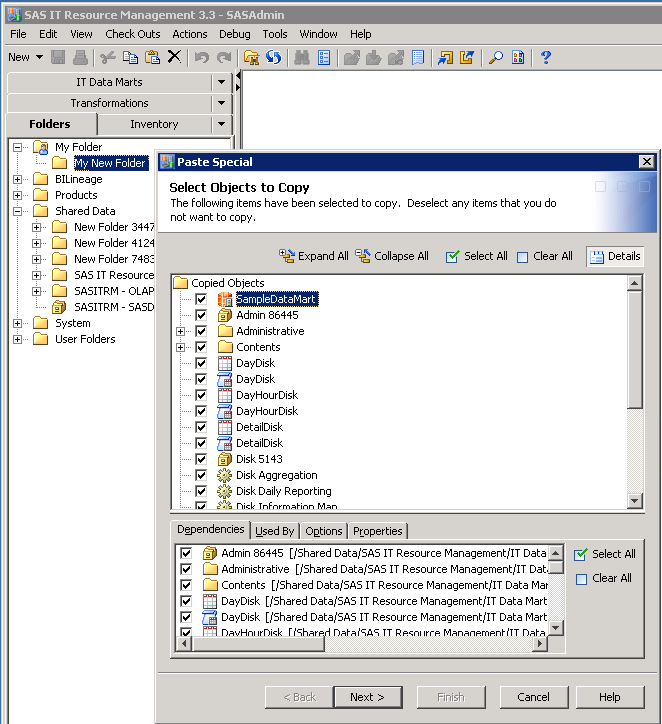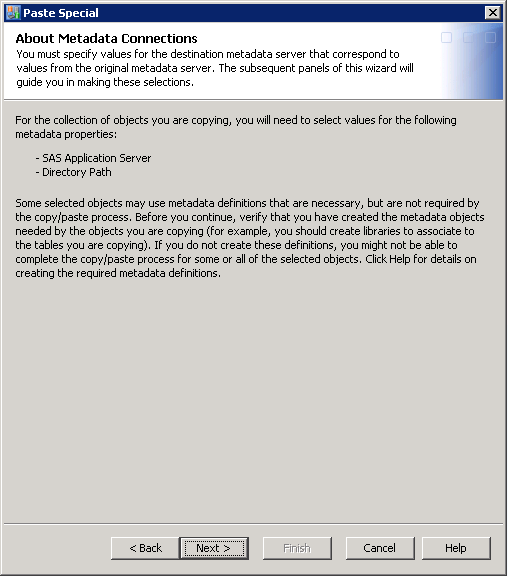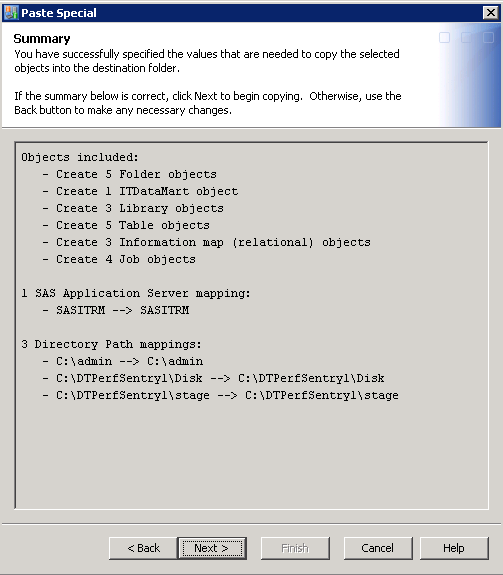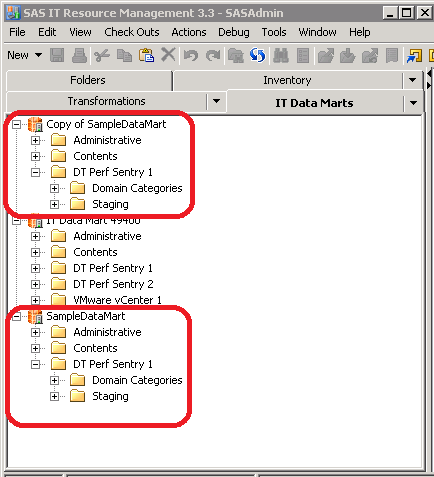Working with IT Data Marts
Copy and Paste an IT Data Mart
-
Determine the folder into which you want to paste the IT data mart. If you want to create a new folder for the IT data mart, from the Folders tree, click New. From the drop-down list, select Folder. The New Folder wizard appears. You can retain the default name of the new folder, or you can enter a new name. You can also retain the default location, or you can click Browse to navigate to another location. Select the location that you want to use. Click OK to create the new folder.
-
To do so, in the Folders tree, right-click the folder into which you want to paste the IT data mart. Then select one of the following actions:
Create an IT Data Mart
-
On the General information page of the wizard, specify the name, description, and location of the IT data mart.
-
The Location field contains the default location for the IT data mart. A value is required in this field. This location is typically in the
Shared Data\SAS IT Resource Managementfolder of the repository where you are logged on. You can modify this field to specify any location to which you have Write privileges. The wizard does not permit you to enter invalid characters.
-
Application servers store and execute SAS code. The default application server that is specified with this wizard accesses metadata, DBMS tables, and external files on remote hosts so that it can build and support an IT data mart. A value is required in this field.Select the default application server from the drop-down list of currently defined SAS Application servers. Then click Test Connection to make sure that you are connected to the server that you specified. If you are not connected at this time, you are prompted to enter your user ID and password in order to access the server.
-
On the Root path information page, specify the path that will be used for the creation of the physical libraries. The path that you specify should be a fully qualified path; relative paths are not supported. A value is required in this field. You can enter the path in the field. Alternatively, you can click Browse and select a root path from the Select a Directory dialog box that displays the directory structure on your file system. IT data marts with invalid root path will not be created and an error message that explains the problem will be displayed. This physical path is not validated. Make sure that each IT data mart uses a different path. The value for this field cannot contain the single quotation character
('). Browse is disabled when the selected application server is running on a machine that uses thez/OS z/OS z/OS MY.DATAMART) or a root directory in the UFS hierarchical file system (/u/myname/datamart).Note: The documentation for SAS onz/OS has traditionally used the terms UNIX System Services (USS) and hierarchical file system (HFS) to refer to the UNIX file system onz/OS . The SAS 9.3 documentation uses the terms UNIX file system and UFS to refer to this file system. In addition to the original HFS implementation, thez/OS operating system also provides another UNIX file system known as thez/OS file system (zFS). zFS, which provides certain performance and manageability benefits, is functionally equivalent to HFS from the perspective of a SAS user.
Delete an IT Data Mart
Deleting an IT data mart removes all the metadata that
is associated with the IT data mart. It does not remove the physical
tables. To delete an IT data mart and all its contents, perform the
following steps:
-
On the IT Data Marts tree of SAS IT Resource Management, right-click the IT data mart that you want to delete. (Make sure that the jobs that are located in that IT data mart are not open in a Diagram tab of the Job Editor window.)Note: You can also access the Delete function from the Folders tree of SAS IT Resource Management. However, performing tasks on the IT data mart from any tree other than the IT Data Marts tree is not recommended because the metadata that is associated with the IT data mart might not be properly updated.
Erase an IT Data Mart
Erasing an IT data mart deletes all the SAS libraries
and their contents from the metadata. It also deletes all empty directories
at the root level of the IT data mart. (The Erase action
does not delete any directories that have contents.) It also deletes
all the metadata that is in the IT data mart. To erase an IT data
mart and all its contents, perform the following steps:
-
On the IT Data Marts tree of SAS IT Resource Management, right-click the IT data mart that you want to delete. (Make sure that the jobs that are located in that IT data mart are not open in a Diagram tab of the Job Editor window.)Note: You can also access the Delete function from the Folders tree of SAS IT Resource Management. However, performing tasks on the IT data mart from any tree other than the IT Data Marts tree is not recommended because the metadata that is associated with the IT data mart might not be properly updated.
Purge the Tables of an IT Data Mart
Rename an IT Data Mart
Note: If the renaming of the IT
data mart includes moving it to another folder, perform the Move
to Folder task in the Folders view. Then, perform the
renaming task in the IT Data Marts view.
Alternatively, you can
rename the IT data mart by right-clicking the IT data mart and selecting Properties.
Select the General tab. Enter the new name
of the IT data mart in the Name field. If
you rename an IT data mart to the same name as an existing IT data
mart, a message is displayed that warns that the new name is already
in use for another IT data mart.
Note: In any job, if you have explicitly
specified the path to an IT data mart, and you subsequently rename
that IT data mart, then you should change the name of the IT data
mart in that explicitly specified path. In addition, if you change
any other folder name that is used in an explicit path reference,
you should ensure that the explicitly specified path uses the changed
folder name.
